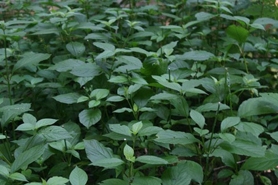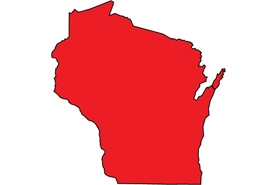Japanese chaff flower
(Achyranthes japonica)
Herbaceous perennial with opposite leaves, growing up to 1-2 meters tall. Fruits lay flat against elongated spikes that have a pair of stiff bracts. Seeds easily hitch a ride on clothing, shoes, and animal fur.
Other names for this plant include:
- Common names: Japonica
- Scientific names: Achyranthes bidentata var. japonica
Classification in Wisconsin: Prohibited
- Ecological Threat
-
- Thrives in partial sun and moist soils but is also tolerant of conditions such as deep shade and dry soils.
- It invades forests, riparian areas, open grasslands, and disturbed areas such as ditches and field edges.
- It can produce thousands of seeds per square meter with nearly 100% viability and rapid germination.
- Forms dense colonies (documented at over 70 plants per square meter), out-competing native herbaceous plants and reducing overall forest regeneration.
- Seeds are easily spread by human activity.
- Identification
-
Leaves & stems: Simple, opposite, ovate-elliptic shaped. Leaf margins are entire and slightly wavy. It somewhat resembles common pigweed with the venation of dogwood. The whole plant is barely pubescent (covered in tiny, soft hairs).
Flowers: Flowers occur on tight clusters of erect spikes, blooming in late summer. Tiny flowers lack petals. The flowers form right angles from the end, giving them a "bottle-brush" appearance. Flowering occurs in late summer.
Fruits & seeds: Fruits lay flat against elongated spikes with stiff bracts that aid in attachment to clothes, shoes, and animal fur. Seed maturation occurs in early fall. The stems and fruit remain erect into winter as plants senesce and leaves die back.
Roots: Vigorous root systems give rise to multiple stems.
Similar species: Japanese chaff flower resembles American lop seed (Phryma leptostachya; native), a common perennial forb of Wisconsin, especially when in fruit. American lop seed can be best distinguished from the Japanese chaff flower by its toothed leaves at an elongated point at the tip.
- Distribution
-
Currently, there have been no reports of Japanese chaff flowers in Wisconsin. Have you seen it? Please send us a report.
- Control
-
Mechanical:
- Manual control is most effective for small infestations or newly germinated plants.
- Because of established populations' highly robust root systems, continual regrowth monitoring is needed after hand-pulling mature plants.
- Be sure to remove plants before the seed set.
- Herbicide treatments may need to be conducted every two weeks to control plants as they germinate.
- Effective control can be had with foliar applications of glyphosate or triclopyr at a 2% rate.
- Control activities should be conducted before or at the onset of flowering. Herbicide applications born after seed production began were found to have decreased effectiveness.
- River-to-River Cooperative Weed Management Area in southern Illinois is currently conducting tests of Garlon3A, Rodeo, and 2, 4-D at the 2% rate.
- Resources
- Sources for content:
- USDA, ARS, National Genetic Resources Program. Germplasm Resources Information Network - (GRIN) [Online Database]. National Germplasm Resources Laboratory, Beltsville, Maryland.
- River to River Cooperative Weed Management Area; Christopher Evans, September 2010
- Wildland Weeds Newsletter; Christopher Evans, River to River Cooperative Weed Management Area and David Taylor, Daniel Boone National Forest. Summer/Fall 2011.
- Japanese Chaff Flower Summit 2011 – Falls of the Ohio State Park, IN; History and Identification of Japanese Chaff Flower (Achyranthes japonica), Notes from the Discussion on Control.


